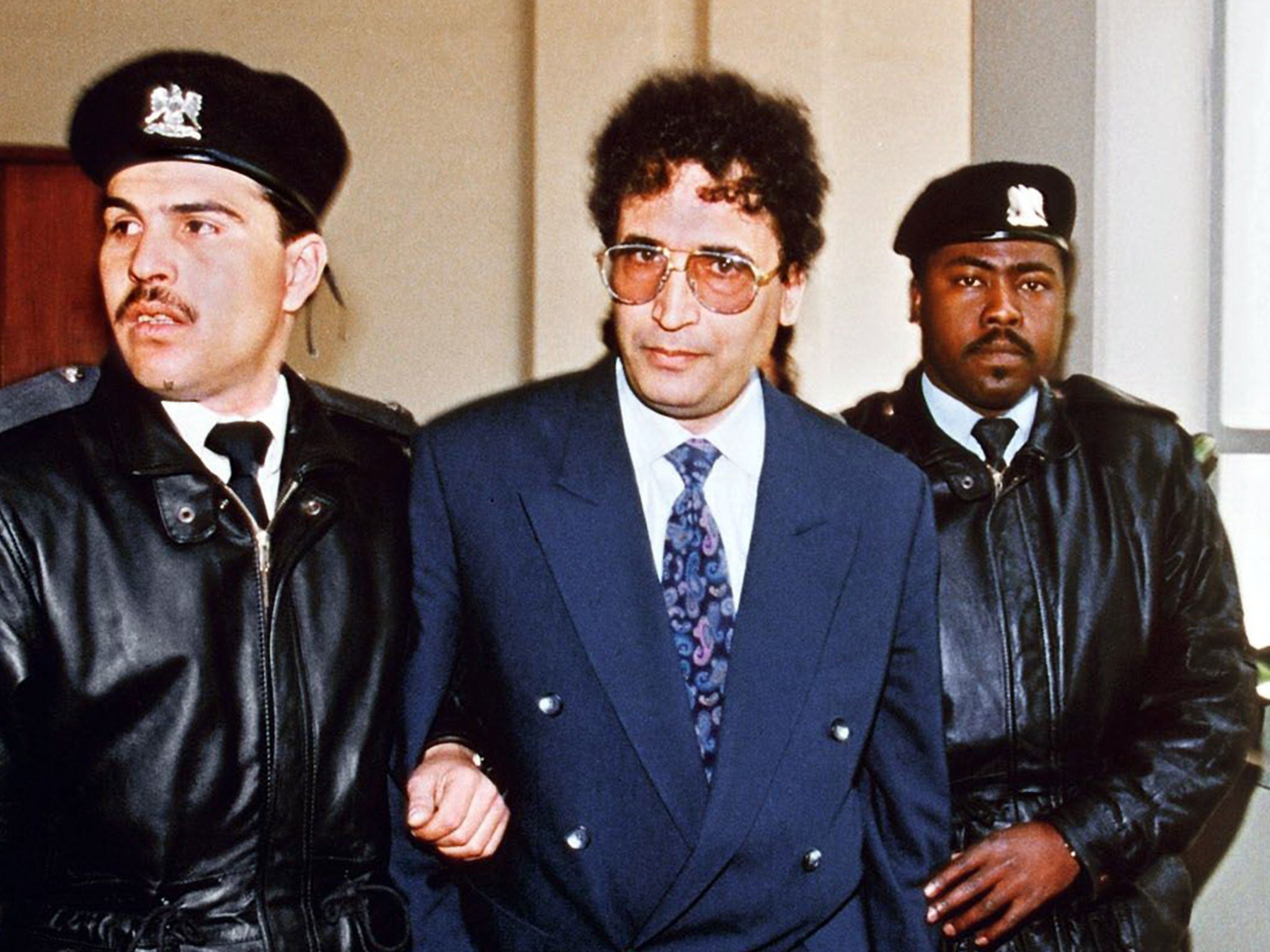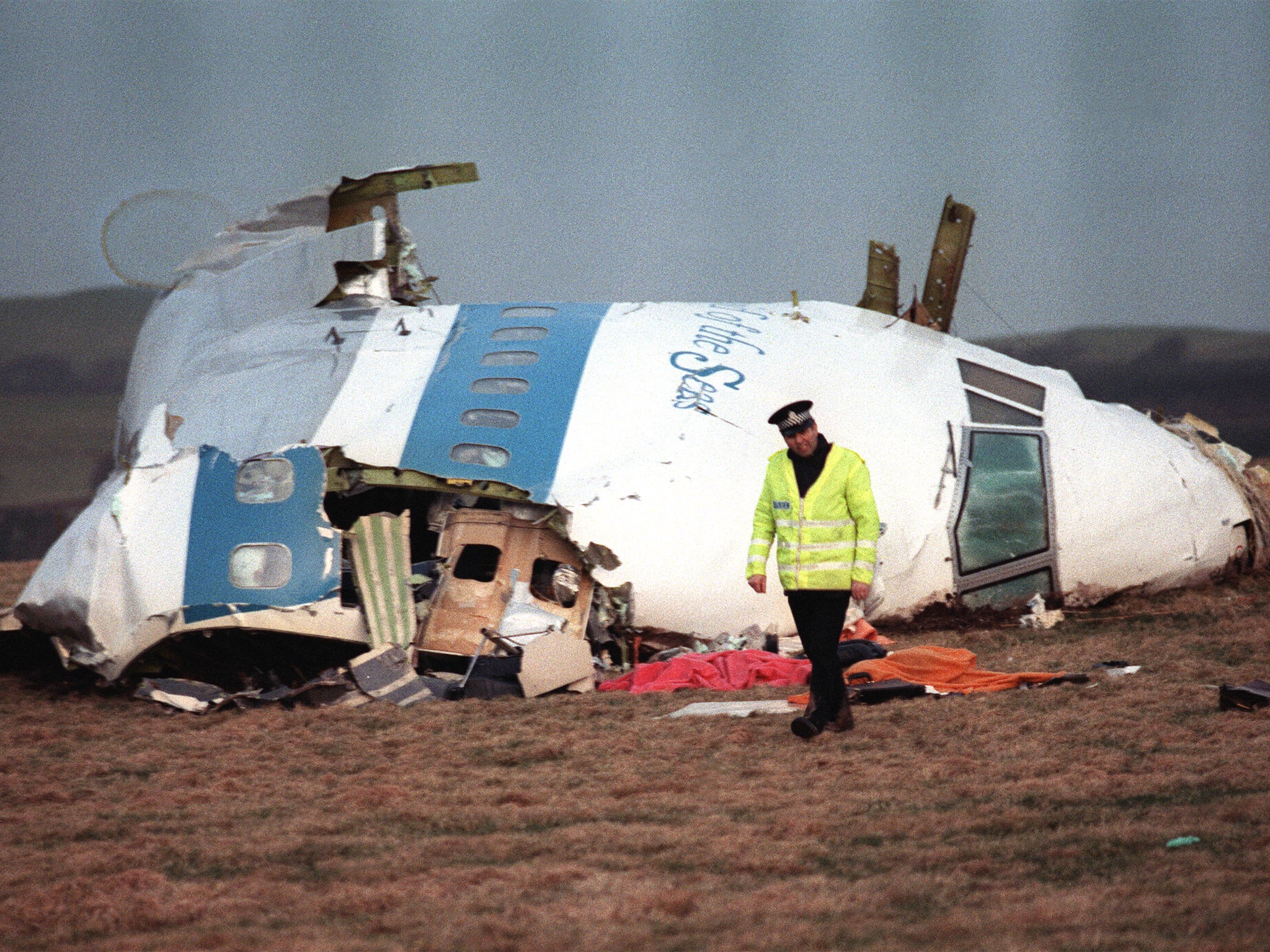Thirty years ago I saw Lockerbie on fire – but I have yet to see justice done
Kim Sengupta reflects on a grotesque act of terrorism that led to 270 deaths and a legal saga which left many unanswered questions


Abdelbaset al-Megrahi lay in his bed attached to a drip, on red sheets stained by dark splashes of blood he had coughed up. An oxygen mask covered his skeletal face; his body twitched as he drifted in and out of consciousness. He was in the advanced stages of cancer: medicine he desperately needed had been plundered by looters; the doctors who had been treating him had fled.
This was in Tripoli in the winter of 2011, in the turmoil of Libya’s civil war and the chaotic aftermath of the fall of Muammar Gaddafi. It was a time of great violence, a dozen bodies were piled up beside a roundabout a half mile from where I had seen Megrahi lie slowly dying. They were corpses of black men lynched by the rebels because they were supposedly mercenaries fighting for the regime: though in reality, they were victims of xenophobia against African migrants which had accompanied the uprising.
Megrahi himself had been convicted of a dreadful massacre; of being responsible for 270 deaths on 21 December 1988, when Pan Am Flight 103 blew up over the town of Lockerbie in Scotland. A bomb – 12 ounces of Semtex in a Toshiba radio-cassette player – had been secreted in the luggage of the plane carrying passengers to the US, many returning home for Christmas.

After spending eight years in Scottish prisons following his conviction, Megrahi had been returned to Libya on compassionate grounds following a diagnosis of prostate cancer. After a few months in prison in Tripoli, unable to walk and bedridden, he was allowed to return to his family home.
There was vengeful anger expressed by some in Britain, and more so in the US, at Megrahi’s return to Libya. He had faked his illness, it was claimed, and even if that was not the case, he had escaped justice by not actually dying in a cell. The charge of subterfuge was reinforced by the perception that his release was part of the many dodgy deals between Tony Blair’s government and Colonel Gaddafi’s regime.
Yet there are good reasons to believe that the conviction of Megrahi was a shameful miscarriage of justice and that, as a result, the real perpetrators of one of the worst acts of terrorism in recent history remained free. That certainly was the view of many, including international jurists, intelligence officers, journalists who followed the case, and members of bereaved families. Among the latter group was Jim Swire, who lost his daughter Flora in the bombing.
Dr Swire, a man of integrity and compassion, who became a spokesman for “UK Families 103” stressed that “the scandal around Megrahi is not that a sick man was released, but that he was even convicted in the first place. All I have ever wanted to see is that the people who murdered my daughter are brought to justice.”
Megrahi died in May 2012, a few months after I had seen him. Yet a campaign Dr Swire had helped set up, “Justice for Megrahi”, continues to help the Libyan’s family to seek a new appeal against the sentence in their efforts to posthumously clear his name.
Certainly, the chronology of the original investigation into the bombing is strange, raising serious questions about the official narrative.
Soon after the downing of the Pan Am flight, American and British security officials began laying the blame on an Iran-Syria axis. The suggested scenario was that Tehran had taken out a contract in revenge for the destruction of an Iranian civilian airliner (Iran Air Flight 655), which had been shot down by missiles fired from an American warship (the USS Vincennes) a few months earlier. The theory went that the contract had been taken up by the PFLP-GC (Popular Front for the Liberation of Palestine-General Command) which specialised in such operations.
Hundreds die as jumbo jet plunges into town
How The Independent first reported the news
Hundreds of people died last night when a Pan American jumbo jet carrying more than 250 people on a flight from London to New York broke up in mid-air and plunged on to the small Scottish town of Lockerbie.
The cause of the crash was not known last night, but a Pan Am spokesman, Jeff Kriendler, said “an incident” had occurred while the aircraft was flying at an altitude of 31,000 ft, but he refused to elaborate or speculate on the possible cause of the disaster. Since the craft was carrying a large number of US servicemen there was speculation that it could have been a terrorist bomb.
Early this morning, John Boyd, the Chief constable of Dumfries and Galloway, said that all 273 people on board were presumed dead. The number of ground casualties was still being assessed.
“The wreckage is spread over a very wide area – probably about 10 miles in radius. Parts of the wreckage have fallen on two residential areas in the town, causing considerable damage and setting fire to a number of houses.”
The town, 10 miles south-west of Dumfries, was devastated by a fireball 300 feet high as people ran from their homes in terror. The explosion blew a crater 20 feet deep and 100 feet long near the centre of the town, destroying many houses and killed a large number of townspeople. Early today, the whole of the southern side of the town was still on fire.
The blame switched to Libya, then very much a pariah state, around the time Iran and Syria joined the US-led coalition against Saddam Hussein in the first Gulf war. Robert Baer, the former American intelligence officer and author, was among those who held that the Iranian sponsored hit was the only plausible explanation for the attack. This was the firm belief held “to a man”, he stated, by his former colleagues in the CIA.
After years of wrangling, Megrahi, the former head of security at Libyan Airlines and allegedly a Libyan intelligence officer, was finally extradited in 1999 – along with another man named as a suspect over the bombing, Lamin Khalifa Fhimah, also allegedly employed by Libyan intelligence. The move came at a time when Colonel Gaddafi was in the process of getting back from into the international fold with the help of the British government.
I covered their trial at Camp Zeist in the Netherlands, which took place in a specially constituted court, with a panel of Scottish judges, but without a jury, under Scots law. The two men were effectively charged with joint enterprise, conspiracy. Yet only Megrahi was found guilty. Fhimah had a cast iron alibi which the judges could not ignore. So, deprived of finding a partner in crime for Megrahi, the prosecutor switched to claiming, and the judges accepting, that he had conspired with himself.
The prosecution evidence was circumstantial; details of the bomb timer on the plane was contradictory; and the testimony of a key witness, a Maltese shopkeeper, extremely shaky under cross-examination. Five years on from the trial, the former Lord Advocate, Lord Fraser of Carmville – who had been responsible for initiating the Lockerbie prosecution – famously described the witness, Tony Gauci, as “an apple short of a picnic” and “not quite the full shilling”.
The performance and evidence of a supposedly prime “CIA intelligence asset”, Abdul Majid Giaka, codenamed “Puzzle Piece” who turned up in a Shirley Bassey wig, was widely viewed as risible. It emerged later that important evidence had not been passed on to the defence lawyers. Ulrich Lumpert, an engineer who testified to the validity of a key piece of evidence, admitted later in an affidavit of lying to the court.
The observer for the UN at the trial severely criticised the verdict as did many lawyers. Robert Black, a law professor born in Lockerbie, who played an important role in organising the Camp Zeist proceedings, later became convinced that a great injustice had taken place.
Behind the controversy, accusations and recriminations over who carried out the attack lay the human tragedy of Lockerbie, a scene which is difficult to forget, even after three decades, for many of us who went there.
The memories which remain are of roads covered by slates blown off roofs, homes burnt out, a huge section of fuselage lying on top of a flattened row of houses.
Devastation as airliner with more than 270 on board breaks apart in mid-air
How The Independent first reported the news, cont.
Parts of the aircraft landed up to 18 miles away from the town. Last night the fire brigade said that 16 bodies, including some of the crew, had been recovered from the front section of the plane, found four miles to the east of Lockerbie in a heavily wooded area. One of the rescue helicopter crews spotted the section. Another helicopter discovered two bodies, one of which was a child, at least two miles away.
First reports said that six or seven townspeople had died, but the final death toll is expected to rise. The main portion of the aircraft narrowly avoided a petrol station, but hit a number of houses and a flyover in the town itself. Vehicles on the A74 Glasgow to Carlisle road, which runs through the town were hit and exploded into flames. Some drivers are reported to have died.
Last night, the massive rescue operation involved all the emergency services. RAF and Army rescue teams and helicopters all working in what were described as horrendous conditions made worse by bad weather.
By midnight, a list of 50 townspeople whose homes were damaged but who survived unhurt was pinned to the outside of the Town Hall, used as an emergency mortuary. Bodies were taken to the mortuary by soldiers.
And bodies. Bodies which had fallen out of the sky, on farmland around the village, on a golf course, but also on buildings and peoples hedges, gardens and driveways, among scattered luggage and plane seats.
Eleven people on the ground had been killed too – very sad losses, though it seemed astonishing that the number wasn’t higher considering the scale of what had taken place.
There was overwhelming shock and grief among the residents as well as those who were arriving by the hour, the emergency services, the media and volunteers who came to help from surrounding areas. People gathered at pubs, one of them the St Mungo Arms I recall, to speak quietly about those missing and about what they had experienced themselves.
The search for bodies ended six weeks later. All of the 243 passengers and 16 crew members on Flight 103 were dead, inevitably. They came from 21 countries: 190 were American and 43 were British citizens. The families of some of the foreign victims went to Lockerbie in the following weeks and months; the people of the town opened their doors to them.
A little later we heard the cold statistical analysis of the disaster. The cockpit and the forward section of the Boeing 747, and those on board had plunged 31,000 feet to the ground, those parts of the aircraft falling on a field near Tudergarth Church, outside Lockerbie. The rest of the plane had gone into a steep dive from 31,000 feet to 19,000 feet before breaking up over the town – the two wings and the fuel tanks landing on a road, Sherwood Crescent. Around 1,500 tonnes of material was blown into the air, a crater of 145 feet gouged out of the ground.
The 30th anniversary of the Lockerbie bombing this week will be marked by a “walk of peace” with people asked to gather at Burnswalk, an ancient landmark near the town; and there will be a special remembrance service at Tundergarth Church.
The Very Reverend Dr Alan McDonald, a former Moderator of the General Assembly of the Church of Scotland, who will lead the service, said: “The people who have been organising the service, and the walk the next day, wanted something that would focus on hope and the future. We will seek hope and peace for all on these days”.

Dr Jan Hogarth, one of the organisers, added: “We hope to help shift people’s perspective from an area associated with tragedy to a special spiritual landscape with a courageous community who held this tragedy with love, compassion, and kindness.
“Thirty years on, you would hope humanity would work towards achieving peace. We don’t have time to look backward, we must work together to achieve this ambition.”
Father Patrick Keegans had just been appointed as parish priest in Lockerbie and was looking forward to his first Christmas there at the time of the crash. His tireless work with the traumatised community drew wide praise and is remembered with gratitude.
He reflected: “For those of us who experienced Lockerbie, the story will never come to an end. Lockerbie lives with us, we are part of Lockerbie and Lockerbie is part of us: the horror, the tragedy, the sadness, the grief, the support and the love that was shown – all of that stays with us.”
Father Keegans, who is now retired, joined the “Justice for Megrahi” campaign after meeting the convicted man’s family and is now backing the call for a fresh appeal.
“I can’t live with myself being silent,” he explained, “when I’m truly convinced that this man has been unjustly convicted; Lockerbie is an unfinished story as far as the legal aspects are concerned.”
Megrahi died at his home in Tripoli still protesting his innocence. He thanked Dr Jim Swire and others who had believed in him.
In his final days, he said: “I pray for all those who died every day.
“I shall be meeting my God soon, but the truth will come out, I really hope the truth of what really happened will come out one day.”
Join our commenting forum
Join thought-provoking conversations, follow other Independent readers and see their replies
Comments